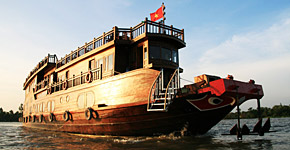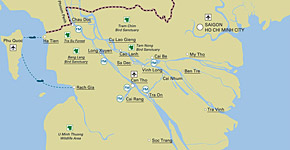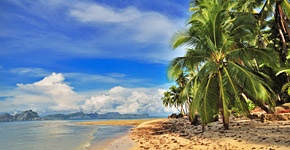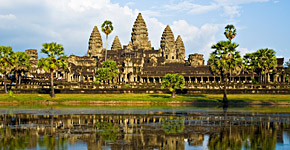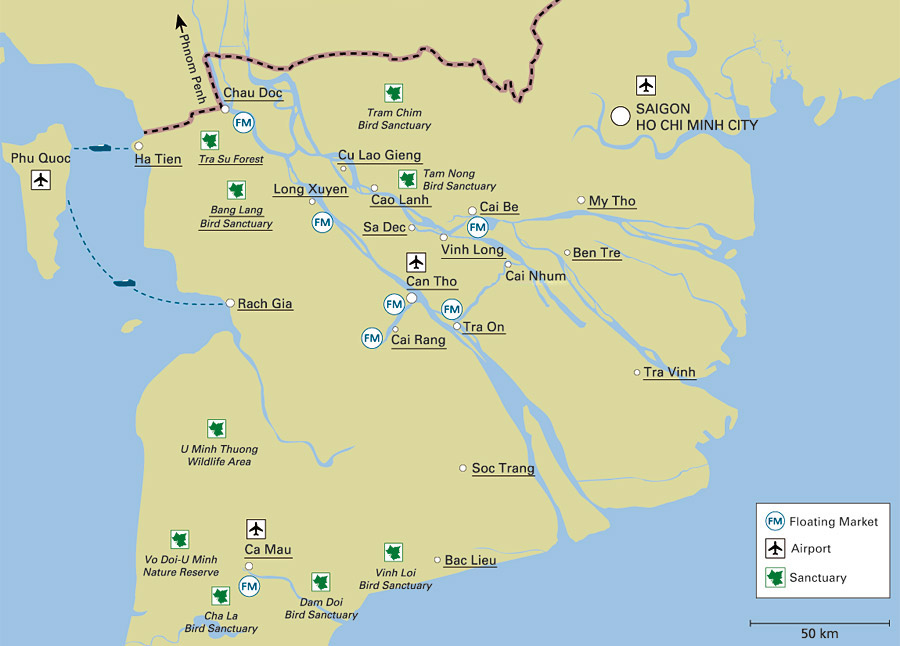Chau Doc - Next to the border to Cambodia
Chau Doc is home for many Khmer, Cham and Chinese and is only a few kilometers from the Cambodian border. The cultural diversity is obvious: the little town has many historical sites, such as the Thoai Ngoc Hau mausoleum and the Quan Cong temple. Chau Doc is located on the Hau Giang diffluence (Bassac River). There is lively boat traffic on the river and also a colourful floating market. The street market is worth a visit too.
Since the opening of the borders in 2000 there was a real boom. Many visitors who travel from Vietnam to Cambodia are passing the nice city. From here there are daily connections to Phnom Penh by speedboat (approx. 5h).
Chau Doc is one of the few places in the delta, which has an excellent hotel: The Victoria Hotel, which is situated directly by the river and offers a magnificent view of the floating houses and fish farms. There are numerous of these floating fish farms and floating houses under which people cultivate fish and freshwater shrimps in nets and wire baskets - a major export product of the region. Since larger companies are now on land this traditional way of fish farming in this particular way is dying out. Mainly catfish and tilapia are being cultivated. Many fish-processing plants have now settled in the neighborhood.
The Cham villages are on the opposite side of the river, near the floating houses and are accessible by boat. Here you can visit the great and modern Chau Giang mosque and the Koranic school which is affiliated with it.
High mountains - once islands in the sea
The surrounding mountains, the highest mountain is 700 meters high, are an extremely rare sight in the Mekong delta. These mountains once were islands in the sea, which were integrated into the landmass by the spread of alluvial land by the Mekong river.
The city of Chau Doc is also a starting point for excursions to the holy Sam Mountain (about 5 km away). On this 230 m high mountain you can have a gorgeous view of Chau Doc, the surrounding plantations, rice fields, small canals and the mighty Hau River, up to the Cambodian border. You can climb the mountain either by foot in about 45 minutes (2 km one way) or by a motorbike taxi (Xe om). Along the way there are numerous stations with refreshments and even a café at the top. Halfway you can find the newly built Tay An temple. The Sam Mountain is the fitness centre of Chau Doc, many locals gather here early in the morning for their morning exercise.
The highest mountain in the region Cam Mountain (716 meters) is located about 40 km south of Chau Doc and attracts many Vietnamese tourists. International tourists are rare.
Colourful Temples
In the town situated at the bottom of Sam Mountain are many important places for pilgrims, such as the temple of Lady Xu and the magnificent decorated Tay An Pagoda, which was built in 1847 with influences from Hinduism and Islam. They belong to the most popular temples in Southern Vietnam. Because of the numerous pilgrims, this is a very lively place.
The smelly Mam-fish belongs to the culinary specialty of the region. This fish is basically left over after the fish sauce production (Nuoc Mam). Numerous factories, which produce the fish sauce, are located in the vicinity of Chau Doc.
About 20 km from Chau Doc is the bird sanctuary Tra Su. People who want to visit Tra Su Forest should calculate at least 3 hours to see everything (for more information see Tra Su Forest).
Between Chau Doc and Long Xuyen you can find the archaeological site Oc Eo. This is believed to have been an important port city in the kingdom of Funan, who ruled the Mekong delta between the first and seventh centuries. Most of the excavations however were brought to the museums in Can Tho and Saigon.
